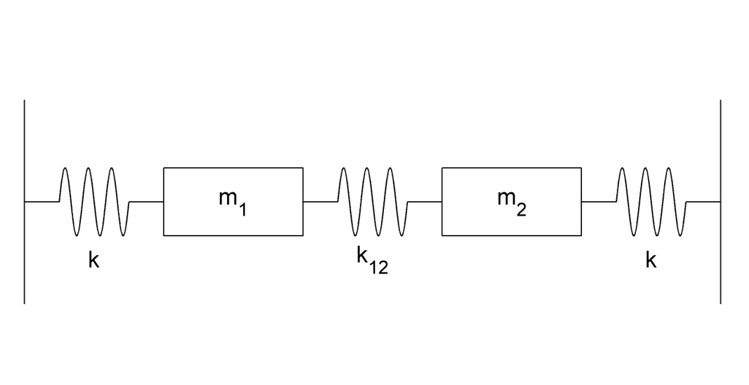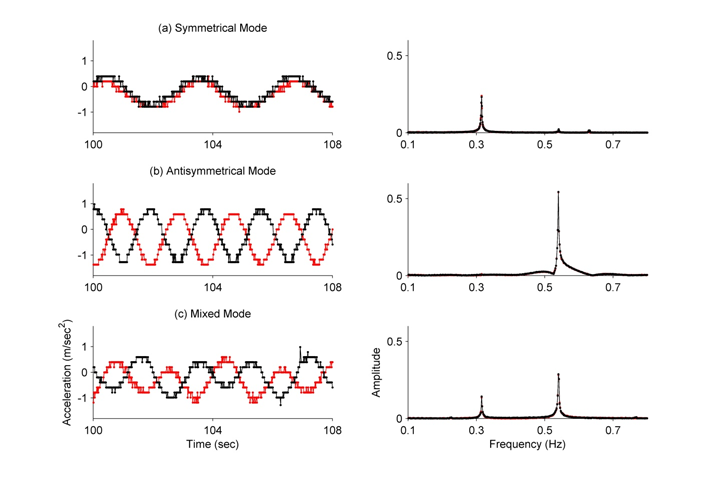An intermediate-level physics laboratory: A system of two coupled oscillators with low-cost accelerometers
Mary Lamont and Minjoon Kouh
Physics Department, Drew University, Madison, NJ
Wiimote is a wireless controller for the Nintendo Wii game system. This device can measure acceleration along three orthogonal axes and broadcast the data via Bluetooth, which can be captured and recorded by free software like GlovePIE (http://www.glovepie.org). Recently, there have been a number of reports on the innovative usage of Wiimotes in physics laboratory and demonstration projects, such as vector decomposition on an inclined plane, harmonic and circular motions, collision, and other motion-tracking experiments1,2,3.
Using commonly available equipments (springs, airtrack, and aircarts) and Wiimotes (Figure 1), we have designed an intermediate-level mechanics experiment about a system of two coupled oscillators. This experiment complements standard theoretical coverage of this important topic, and provides an opportunity to incorporate a lesson on data analysis and scientific-computing software.
As covered in many mechanics textbooks (such as4), a system of two coupled oscillators can be described by a set of coupled differential equations, and has two normal modes, commonly referred to as the symmetric and antisymmetric modes. The symmetric mode occurs when both masses are displaced equally from their equilibrium positions in the same direction. The antisymmetric mode occurs when the masses are displaced in the opposite directions from the equilibrium positions. In general, the masses will oscillate as a combination of the two modes. The frequencies of the normal modes are determined by the spring constants and the masses.
Sample data from our setup are shown in Figure 2 for the symmetric and antisymmetric modes, as well as the mixed modes, over a few seconds. We have performed the discrete Fourier analysis on the acceleration data, using the FFT function in Matlab5,6. As expected, the Fourier transformation of the pure mode reveals a single peak, and that of a mixed mode reveals two peaks at the expected frequencies (in our case, 0.3 and 0.6 Hz).
As further explorations, we have (a) varied the starting positions of the two masses, and analyzed the relative amplitudes of the two normal modes, which depend on the initial conditions, and (b) analyzed the mass-dependence of the frequencies, by putting extra weights on the aircarts. In both cases, there was a good agreement between the theory and the experimental data. For details, please see the extended version of this report7.
By incorporating a low-cost wireless accelerometer and scientific-computing software, we have designed an intermediate-level mechanics experiment, suitable for typical sophomore or junior physics students in college, allowing them to study this important topic in quantitative details, to deepen the understanding of the theoretical concepts about normal modes and Fourier analysis, and to learn and use computational tools. With its $40 price, 100-Hz sampling rate, and within-5% accuracy, this relatively new sensor package opens up many possibilities for innovative lab experiments beyond the first year of physics curriculum.


Figure 1. Experimental setup. Two aircarts per Wiimote were necessary to provide enough lift on the airtrack.

Figure 2. Sample trials with different initial positions of two aircarts. The accelerometer data from two Wiimotes (left) and their FFT analyses (right) are shown.
References
- R. Ochoa, F. G. Rooney, and W. J. Somers. “Using the Wiimotes in introductory physics experiments.” The Physics Teacher. Vol. 49 (2011)
- A. Kawam and M. Kouh. “Wiimote experiments: 3D inclined plane.” The Physics Teacher (2011)
- S. Tomarken et al. “Motion tracking in undergraduate physics laboratories with the Wii remote.” American Journal of Physics. Vol. 80 (2012)
- J. Marion. “Classical dynamics of particles and systems” (2nd Ed.) Academic Press (1970).
- N. Preyer. “The coupled harmonic oscillator: Not just for seniors anymore.” The Physics Teacher. Vol. 34 (1996)
- D. Easton. “Simplifying the motion of coupled oscillators using FFT.” The Physics Teacher. Vol. 44 (2006)
- M. Lamont and M. Kouh. “An intermediate-level physics laboratory: A system of two coupled oscillators with low-cost accelerometers.” arXiv.org: phy-ed (2012)
Disclaimer–The articles and opinion pieces found in this issue of the APS Forum on Education Newsletter are not peer refereed and represent solely the views of the authors and not necessarily the views of the APS.
